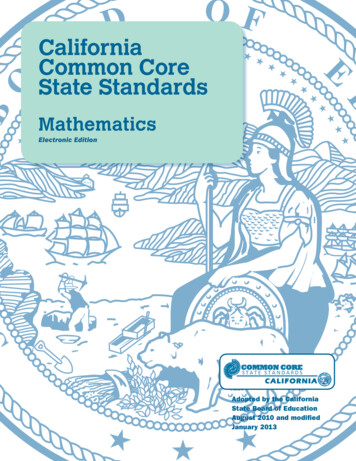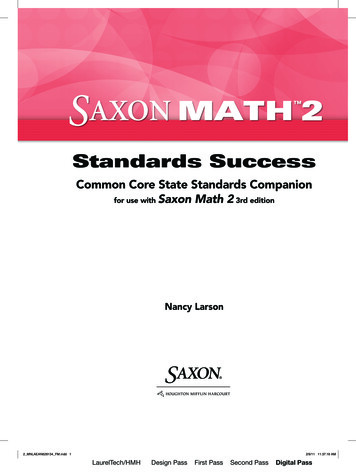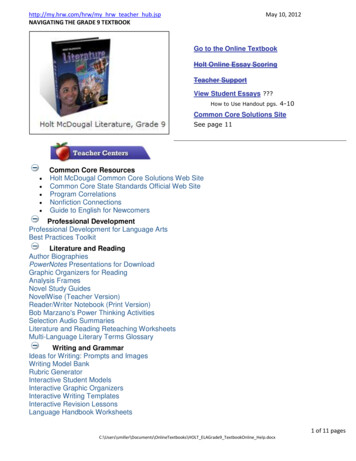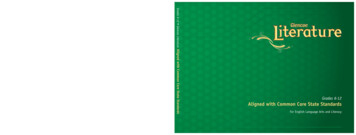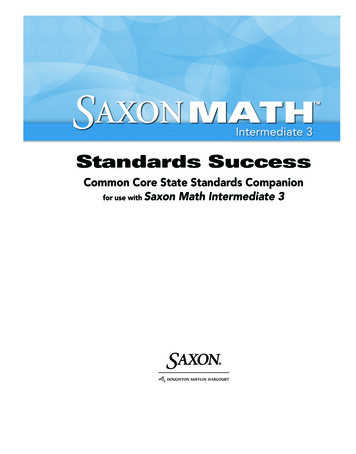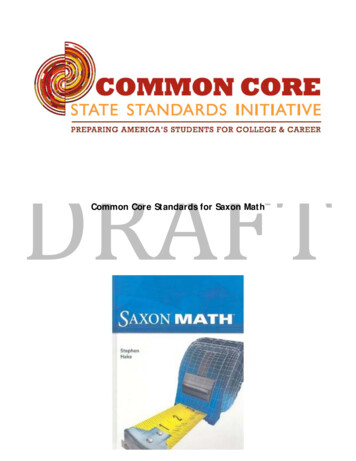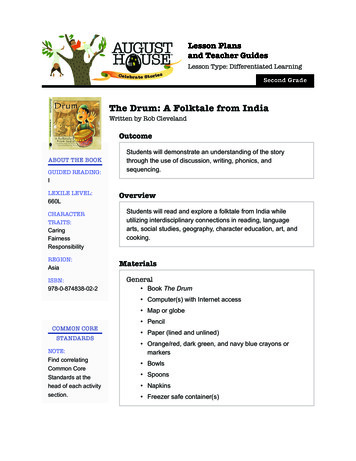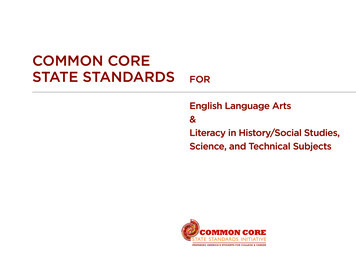
Transcription
Common CoreState StandardsforEnglish Language Arts&Literacy in History/Social Studies,Science, and Technical Subjects
Common Core State Standards for ENGLISH LANGUAGE ARTS & Literacy in History/Social Studies, Science, and Technical SubjectsTable of ContentsIntroductionStandards for English Language Arts & Literacy in History/Social Studies, Science, and Technical Subjects K–5College and Career Readiness Anchor Standards for Reading3910Reading Standards for Literature K–511Reading Standards for Informational Text K–513Reading Standards: Foundational Skills K–515College and Career Readiness Anchor Standards for Writing18Writing Standards K–5192 TABLE OF CONTENTSCollege and Career Readiness Anchor Standards for Speaking and Listening 22Speaking and Listening Standards K–523College and Career Readiness Anchor Standards for Language25Language Standards K–526Language Progressive Skills, by Grade30Standard 10: Range, Quality, and Complexity of Student Reading K–531Staying on Topic Within a Grade and Across Grades33Standards for English Language Arts 6–1234College and Career Readiness Anchor Standards for Reading35Reading Standards for Literature 6–1236Reading Standards for Informational Text 6–1239College and Career Readiness Anchor Standards for Writing41Writing Standards 6–1242College and Career Readiness Anchor Standards for Speaking and Listening 48Speaking and Listening Standards 6–1249College and Career Readiness Anchor Standards for Language51Language Standards 6–1252Language Progressive Skills, by Grade56Standard 10: Range, Quality, and Complexity of Student Reading 6–1257Standards for Literacy in History/Social Studies,Science, and Technical Subjects59College and Career Readiness Anchor Standards for Reading60Reading Standards for Literacy in History/Social Studies 6–1261Reading Standards for Literacy in Science and Technical Subjects 6–1262College and Career Readiness Anchor Standards for Writing63Writing Standards for Literacy in History/Social Studies, Science,and Technical Subjects 6–1264
Common Core State Standards for ENGLISH LANGUAGE ARTS & Literacy in History/Social Studies, Science, and Technical SubjectsIntroductionThe Common Core State Standards for English Language Arts & Literacy inHistory/Social Studies, Science, and Technical Subjects (“the Standards”) arethe culmination of an extended, broad-based effort to fulfill the charge issuedby the states to create the next generation of K–12 standards in order to helpensure that all students are college and career ready in literacy no later than theend of high school.The present work, led by the Council of Chief State School Officers (CCSSO)and the National Governors Association (NGA), builds on the foundation laid bystates in their decades-long work on crafting high-quality education standards.The Standards also draw on the most important international models as wellas research and input from numerous sources, including state departmentsof education, scholars, assessment developers, professional organizations,educators from kindergarten through college, and parents, students, and othermembers of the public. In their design and content, refined through successivedrafts and numerous rounds of feedback, the Standards represent a synthesis ofthe best elements of standards-related work to date and an important advanceover that previous work.As specified by CCSSO and NGA, the Standards are (1) research and evidencebased, (2) aligned with college and work expectations, (3) rigorous, and(4) internationally benchmarked. A particular standard was included in thedocument only when the best available evidence indicated that its mastery wasessential for college and career readiness in a twenty-first-century, globallycompetitive society. The Standards are intended to be a living work: as new andbetter evidence emerges, the Standards will be revised accordingly.3 introductionThe Standards are an extension of a prior initiative led by CCSSO and NGA todevelop College and Career Readiness (CCR) standards in reading, writing,speaking, listening, and language as well as in mathematics. The CCR Reading,Writing, and Speaking and Listening Standards, released in draft form inSeptember 2009, serve, in revised form, as the backbone for the presentdocument. Grade-specific K–12 standards in reading, writing, speaking, listening,and language translate the broad (and, for the earliest grades, seeminglydistant) aims of the CCR standards into age- and attainment-appropriate terms.The Standards set requirements not only for English language arts (ELA)but also for literacy in history/social studies, science, and technical subjects.Just as students must learn to read, write, speak, listen, and use languageeffectively in a variety of content areas, so too must the Standards specifythe literacy skills and understandings required for college and careerreadiness in multiple disciplines. Literacy standards for grade 6 and aboveare predicated on teachers of ELA, history/social studies, science, andtechnical subjects using their content area expertise to help students meetthe particular challenges of reading, writing, speaking, listening, and languagein their respective fields. It is important to note that the 6–12 literacystandards in history/social studies, science, and technical subjects are notmeant to replace content standards in those areas but rather to supplementthem. States may incorporate these standards into their standards for thosesubjects or adopt them as content area literacy standards.As a natural outgrowth of meeting the charge to define college and careerreadiness, the Standards also lay out a vision of what it means to be a literateperson in the twenty-first century. Indeed, the skills and understandingsstudents are expected to demonstrate have wide applicability outside theclassroom or workplace. Students who meet the Standards readily undertakethe close, attentive reading that is at the heart of understanding and enjoyingcomplex works of literature. They habitually perform the critical readingnecessary to pick carefully through the staggering amount of informationavailable today in print and digitally. They actively seek the wide, deep, andthoughtful engagement with high-quality literary and informational textsthat builds knowledge, enlarges experience, and broadens worldviews.They reflexively demonstrate the cogent reasoning and use of evidencethat is essential to both private deliberation and responsible citizenship in ademocratic republic. In short, students who meet the Standards develop theskills in reading, writing, speaking, and listening that are the foundation for anycreative and purposeful expression in language.June 2, 2010
Common Core State Standards for ENGLISH LANGUAGE ARTS & Literacy in History/Social Studies, Science, and Technical SubjectsKey Design ConsiderationsCCR and grade-specific standardsResearch and media skills blended into the Standards as a wholeThe CCR standards anchor the document and define general, cross-disciplinaryliteracy expectations that must be met for students to be prepared toenter college and workforce training programs ready to succeed. The K–12grade-specific standards define end-of-year expectations and a cumulativeprogression designed to enable students to meet college and career readinessexpectations no later than the end of high school. The CCR and high school(grades 9–12) standards work in tandem to define the college and careerreadiness line—the former providing broad standards, the latter providingadditional specificity. Hence, both should be considered when developingcollege and career readiness assessments.To be ready for college, workforce training, and life in a technological society,students need the ability to gather, comprehend, evaluate, synthesize, andreport on information and ideas, to conduct original research in order to answerquestions or solve problems, and to analyze and create a high volume andextensive range of print and nonprint texts in media forms old and new. Theneed to conduct research and to produce and consume media is embeddedinto every aspect of today’s curriculum. In like fashion, research and mediaskills and understandings are embedded throughout the Standards rather thantreated in a separate section.Students advancing through the grades are expected to meet each year’s gradespecific standards, retain or further develop skills and understandings masteredin preceding grades, and work steadily toward meeting the more generalexpectations described by the CCR standards.Shared responsibility for students’ literacy developmentGrade levels for K–8; grade bands for 9–10 and 11–12The Standards use individual grade levels in kindergarten through grade 8 toprovide useful specificity; the Standards use two-year bands in grades 9–12 toallow schools, districts, and states flexibility in high school course design.A focus on results rather than meansBy emphasizing required achievements, the Standards leave room for teachers,curriculum developers, and states to determine how those goals should bereached and what additional topics should be addressed. Thus, the Standardsdo not mandate such things as a particular writing process or the full range ofmetacognitive strategies that students may need to monitor and direct theirthinking and learning. Teachers are thus free to provide students with whatevertools and knowledge their professional judgment and experience identify asmost helpful for meeting the goals set out in the Standards.4 introductionAn integrated model of literacyAlthough the Standards are divided into Reading, Writing, Speaking andListening, and Language strands for conceptual clarity, the processes ofcommunication are closely connected, as reflected throughout this document.For example, Writing standard 9 requires that students be able to writeabout what they read. Likewise, Speaking and Listening standard 4 sets theexpectation that students will share findings from their research.The Standards insist that instruction in reading, writing, speaking, listening,and language be a shared responsibility within the school. The K–5 standardsinclude expectations for reading, writing, speaking, listening, and languageapplicable to a range of subjects, including but not limited to ELA. The grades6–12 standards are divided into two sections, one for ELA and the other forhistory/social studies, science, and technical subjects. This division reflects theunique, time-honored place of ELA teachers in developing students’ literacyskills while at the same time recognizing that teachers in other areas must havea role in this development as well.Part of the motivation behind the interdisciplinary approach to literacypromulgated by the Standards is extensive research establishing the needfor college and career ready students to be proficient in reading complexinformational text independently in a variety of content areas. Most of therequired reading in college and workforce training programs is informationalin structure and challenging in content; postsecondary education programstypically provide students with both a higher volume of such reading than isgenerally required in K–12 schools and comparatively little scaffolding.The Standards are not alone in calling for a special emphasis on informationaltext. The 2009 reading framework of the National Assessment of EducationalProgress (NAEP) requires a high and increasing proportion of informational texton its assessment as students advance through the grades.
Common Core State Standards for ENGLISH LANGUAGE ARTS & Literacy in History/Social Studies, Science, and Technical SubjectsDistribution of Literary and Informational Passages by Grade inthe 2009 NAEP Reading FrameworkGradeLiteraryInformationalGradeTo PersuadeTo ExplainTo Convey 0%1240%40%20%Source: National Assessment Governing Board. (2008). Reading framework for the 2009 National Assessment of Educational Progress. Washington, DC: U.S. Government Printing Office.Source: National Assessment Governing Board. (2007). Writing framework for the 2011 NationalAssessment of Educational Progress, pre-publication edition. Iowa City, IA: ACT, Inc.The Standards aim to align instruction with this framework so that many morestudents than at present can meet the requirements of college and careerreadiness. In K–5, the Standards follow NAEP’s lead in balancing the readingof literature with the reading of informational texts, including texts in history/social studies, science, and technical subjects. In accord with NAEP’s growingemphasis on informational texts in the higher grades, the Standards demandthat a significant amount of reading of informational texts take place in andoutside the ELA classroom. Fulfilling the Standards for 6–12 ELA requiresmuch greater attention to a specific category of informational text—literarynonfiction—than has been traditional. Because the ELA classroom must focuson literature (stories, drama, and poetry) as well as literary nonfiction, a greatdeal of informational reading in grades 6–12 must take place in other classes ifthe NAEP assessment framework is to be matched instructionally.1 To measurestudents’ growth toward college and career readiness, assessments aligned withthe Standards should adhere to the distribution of texts across grades cited inthe NAEP framework.It follows that writing assessments aligned with the Standards should adhere tothe distribution of writing purposes across grades outlined by NAEP. introductionNAEP likewise outlines a distribution across the grades of the core purposesand types of student writing. The 2011 NAEP framework, like the Standards,cultivates the development of three mutually reinforcing writing capacities:writing to persuade, to explain, and to convey real or imagined experience.Evidence concerning the demands of college and career readiness gatheredduring development of the Standards concurs with NAEP’s shifting emphases:standards for grades 9–12 describe writing in all three forms, but, consistentwith NAEP, the overwhelming focus of writing throughout high school shouldbe on arguments and informative/explanatory texts.25Distribution of Communicative Purposes by Gradein the 2011 NAEP Writing Framework1The percentages on the table reflect the sum of student reading, not just reading in ELAsettings. Teachers of senior English classes, for example, are not required to devote 70percent of reading to informational texts. Rather, 70 percent of student reading across thegrade should be informational.2As with reading, the percentages in the table reflect the sum of student writing, not justwriting in ELA settings.Focus and coherence in instruction and assessmentWhile the Standards delineate specific expectations in reading, writing,speaking, listening, and language, each standard need not be a separate focusfor instruction and assessment. Often, several standards can be addressed bya single rich task. For example, when editing writing, students address Writingstandard 5 (“Develop and strengthen writing as needed by planning, revising,editing, rewriting, or trying a new approach”) as well as Language standards 1–3(which deal with conventions of standard English and knowledge of language).When drawing evidence from literary and informational texts per Writingstandard 9, students are also demonstrating their comprehension skill in relationto specific standards in Reading. When discussing something they haveread or written, students are also demonstrating their speaking and listeningskills. The CCR anchor standards themselves provide another source of focusand coherence.The same ten CCR anchor standards for Reading apply to both literary andinformational texts, including texts in history/social studies, science, andtechnical subjects. The ten CCR anchor standards for Writing cover numeroustext types and subject areas. This means that students can develop mutuallyreinforcing skills and exhibit mastery of standards for reading and writing acrossa range of texts and classrooms.
Common Core State Standards for ENGLISH LANGUAGE ARTS & Literacy in History/Social Studies, Science, and Technical SubjectsWhat is Not Covered by the StandardsThe Standards should be recognized for what they are not as well as what they are. The most important intentional design limitations are as follows:1.2.While the Standards focus on what is most essential, they do notdescribe all that can or should be taught. A great deal is left tothe discretion of teachers and curriculum developers. The aim ofthe Standards is to articulate the fundamentals, not to set out anexhaustive list or a set of restrictions that limits what can be taughtbeyond what is specified herein.3.The Standards do not define the nature of advanced work for studentswho meet the Standards prior to the end of high school. For thosestudents, advanced work in such areas as literature, composition,language, and journalism should be available. This work should providethe next logical step up from the college and career readiness baselineestablished here. introduction4.6The Standards define what all students are expected to know and beable to do, not how teachers should teach. For instance, the use ofplay with young children is not specified by the Standards, but it iswelcome as a valuable activity in its own right and as a way to helpstudents meet the expectations in this document. Furthermore, whilethe Standards make references to some particular forms of content,including mythology, foundational U.S. documents, and Shakespeare,they do not—indeed, cannot—enumerate all or even most of thecontent that students should learn. The Standards must thereforebe complemented by a well-developed, content-rich curriculumconsistent with the expectations laid out in this document.The Standards set grade-specific standards but do not define theintervention methods or materials necessary to support studentswho are well below or well above grade-level expectations. No set ofgrade-specific standards can fully reflect the great variety in abilities,needs, learning rates, and achievement levels of students in any givenclassroom. However, the Standards do provide clear signposts alongthe way to the goal of college and career readiness for all students.5.It is also beyond the scope of the Standards to define the full range ofsupports appropriate for English language learners and for studentswith special needs. At the same time, all students must have theopportunity to learn and meet the same high standards if they are toaccess the knowledge and skills necessary in their post–high schoollives.Each grade will include students who are still acquiring English.For those students, it is possible to meet the standards in reading,writing, speaking, and listening without displaying native-like controlof conventions and vocabulary.The Standards should also be read as allowing for the widestpossible range of students to participate fully from the outset andas permitting appropriate accommodations to ensure maximumparticipation of students with special education needs. For example,for students with disabilities reading should allow for the use ofBraille, screen-reader technology, or other assistive devices, whilewriting should include the use of a scribe, computer, or speech-totext technology. In a similar vein, speaking and listening should beinterpreted broadly to include sign language.6.While the ELA and content area literacy components describedherein are critical to college and career readiness, they do notdefine the whole of such readiness. Students require a wideranging, rigorous academic preparation and, particularly in the earlygrades, attention to such matters as social, emotional, and physicaldevelopment and approaches to learning. Similarly, the Standardsdefine literacy expectations in history/social studies, science, andtechnical subjects, but literacy standards in other areas, suchas mathematics and health education, modeled on those in thisdocument are strongly encouraged to facilitate a comprehensive,schoolwide literacy program.
Common Core State Standards for ENGLISH LANGUAGE ARTS & Literacy in History/Social Studies, Science, and Technical SubjectsStudents Who are College and Career Readyin Reading, Writing, Speaking, Listening, and LanguageThe descriptions that follow are not standards themselves but instead offer a portrait of students who meet the standards set out in this document. As studentsadvance through the grades and master the standards in reading, writing, speaking, listening, and language, they are able to exhibit with increasing fullness andregularity these capacities of the literate individual.They demonstrate independence.They comprehend as well as critique.Students can, without significant scaffolding, comprehend and evaluatecomplex texts across a range of types and disciplines, and they can constructeffective arguments and convey intricate or multifaceted information. Likewise,students are able independently to discern a speaker’s key points, requestclarification, and ask relevant questions. They build on others’ ideas, articulatetheir own ideas, and confirm they have been understood. Without prompting,they demonstrate command of standard English and acquire and use awide-ranging vocabulary. More broadly, they become self-directed learners,effectively seeking out and using resources to assist them, including teachers,peers, and print and digital reference materials.Students are engaged and open-minded—but discerning—readers and listeners.They work diligently to understand precisely what an author or speaker issaying, but they also question an author’s or speaker’s assumptions andpremises and assess the veracity of claims and the soundness of reasoning.They build strong content knowledge.Students establish a base of knowledge across a wide range of subject matterby engaging with works of quality and substance. They become proficientin new areas through research and study. They read purposefully and listenattentively to gain both general knowledge and discipline-specific expertise.They refine and share their knowledge through writing and speaking.They respond to the varying demands of audience, task, purpose,and discipline.7 introductionStudents adapt their communication in relation to audience, task, purpose, anddiscipline. They set and adjust purpose for reading, writing, speaking, listening,and language use as warranted by the task. They appreciate nuances, such ashow the composition of an audience should affect tone when speaking andhow the connotations of words affect meaning. They also know that differentdisciplines call for different types of evidence (e.g., documentary evidence inhistory, experimental evidence in science).They value evidence.Students cite specific evidence when offering an oral or written interpretationof a text. They use relevant evidence when supporting their own points inwriting and speaking, making their reasoning clear to the reader or listener, andthey constructively evaluate others’ use of evidence.They use technology and digital media strategically and capably.Students employ technology thoughtfully to enhance their reading, writing,speaking, listening, and language use. They tailor their searches online toacquire useful information efficiently, and they integrate what they learn usingtechnology with what they learn offline. They are familiar with the strengths andlimitations of various technological tools and mediums and can select and usethose best suited to their communication goals.They come to understand other perspectives and cultures.Students appreciate that the twenty-first-century classroom and workplaceare settings in which people from often widely divergent cultures and whorepresent diverse experiences and perspectives must learn and work together.Students actively seek to understand other perspectives and cultures throughreading and listening, and they are able to communicate effectively withpeople of varied backgrounds. They evaluate other points of view criticallyand constructively. Through reading great classic and contemporary worksof literature representative of a variety of periods, cultures, and worldviews,students can vicariously inhabit worlds and have experiences much differentthan their own.
Common Core State Standards for ENGLISH LANGUAGE ARTS & Literacy in History/Social Studies, Science, and Technical SubjectsHow to Read This DocumentOverall Document OrganizationThe Standards comprise three main sections: a comprehensive K–5 sectionand two content area–specific sections for grades 6–12, one for ELA and onefor history/social studies, science, and technical subjects. Three appendicesaccompany the main document.Each section is divided into strands. K–5 and 6–12 ELA have Reading, Writing,Speaking and Listening, and Language strands; the 6–12 history/ social studies,science, and technical subjects section focuses on Reading and Writing. Eachstrand is headed by a strand-specific set of College and Career ReadinessAnchor Standards that is identical across all grades and content areas.Standards for each grade within K–8 and for grades 9–10 and 11–12 follow theCCR anchor standards in each strand. Each grade-specific standard (as thesestandards are collectively referred to) corresponds to the same-numberedCCR anchor standard. Put another way, each CCR anchor standard has anaccompanying grade-specific standard translating the broader CCR statementinto grade-appropriate end-of-year expectations.Individual CCR anchor standards can be identified by their strand, CCR status,and number (R.CCR.6, for example). Individual grade-specific standards canbe identified by their strand, grade, and number (or number and letter, whereapplicable), so that RI.4.3, for example, stands for Reading, Informational Text,grade 4, standard 3 and W.5.1a stands for Writing, grade 5, standard 1a. Stranddesignations can be found in brackets alongside the full strand title.Who is responsible for which portion of the StandardsA single K–5 section lists standards for reading, writing, speaking, listening,and language across the curriculum, reflecting the fact that most or all of theinstruction students in these grades receive comes from one teacher. Grades6–12 are covered in two content area–specific sections, the first for the Englishlanguage arts teacher and the second for teachers of history/social studies,science, and technical subjects. Each section uses the same CCR anchorstandards but also includes grade-specific standards tuned to the literacyrequirements of the particular discipline(s).8 introductionKey Features of the StandardsReading: Text complexity and the growth of comprehensionThe Reading standards place equal emphasis on the sophistication of whatstudents read and the skill with which they read. Standard 10 defines a grade-bygrade “staircase” of increasing text complexity that rises from beginning readingto the college and career readiness level. Whatever they are reading, studentsmust also show a steadily growing ability to discern more from and make fulleruse of text, including making an increasing number of connections among ideasand between texts, considering a wider range of textual evidence, and becomingmore sensitive to inconsistencies, ambiguities, and poor reasoning in texts.Writing: Text types, responding to reading, and researchThe Standards acknowledge the fact that whereas some writing skills, suchas the ability to plan, revise, edit, and publish, are applicable to many types ofwriting, other skills are more properly defined in terms of specific writing types:arguments, informative/explanatory texts, and narratives. Standard 9 stressesthe importance of the writing-reading connection by requiring students to drawupon and write about evidence from literary and informational texts. Becauseof the centrality of writing to most forms of inquiry, research standards areprominently included in this strand, though skills important to research areinfused throughout the document.Speaking and Listening: Flexible communication and collaborationIncluding but not limited to skills necessary for formal presentations, theSpeaking and Listening standards require students to develop a range ofbroadly useful oral communication and interpersonal skills. Students must learnto work together, express and listen carefully to ideas, integrate informationfrom oral, visual, quantitative, and media sources, evaluate what they hear, usemedia and visual displays strategically to help achieve communicative purposes,and adapt speech to context and task.Language: Conventions, effective use, and vocabularyThe Language standards include the essential “rules” of standard writtenand spoken English, but they also approach language as a matter of craftand informed choice among alternatives. The vocabulary standards focus onunderstanding words and phrases, their relationships, and their nuances and onacquiring new vocabulary, particularly general academic and domain-specificwords and phrases.Appendices A, B, and CAppendix A contains supplementary material on reading, writing, speaking andlistening, and language as well as a glossary of key terms. Appendix B consists oftext exemplars illustrating the complexity, quality, and range of reading appropriatefor various grade levels with accompanying sample performance tasks. AppendixC includes annotated samples demonstrating at least adequate performance instudent writing at various grade levels.
Common Core State Standards for ENGLISH LANGUAGE ARTS & Literacy in History/Social Studies, Science, and Technical SubjectsSTANDARDS FOREnglish Language Arts&Literacy in History/Social Studies,Science, and Technical SubjectsK–5
Common Core State Standards for ENGLISH LANGUAGE ARTS & Literacy in History/Social Studies, Science, and Technical SubjectsCollege and Career Readiness Anchor Standards for ReadingThe
History/Social Studies, Science, and Technical Subjects (“the Standards”) are the culmination of an extended, broad-based effort to fulfill the charge issued by the states to create the next generation of K–12 standards in order to help ensure that all students are college and caree
